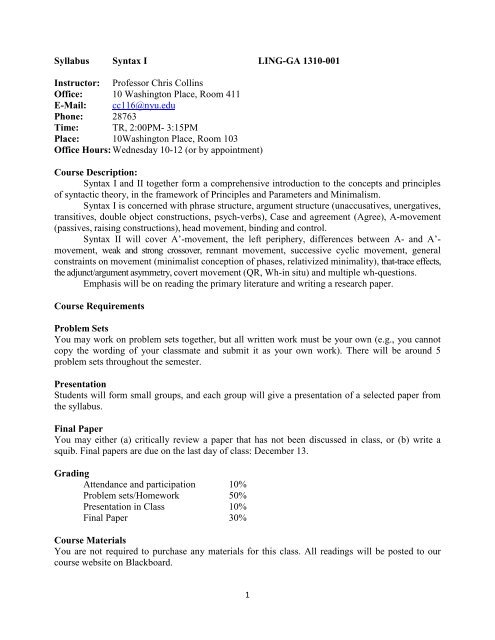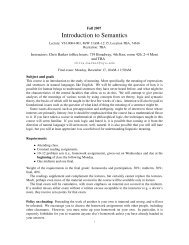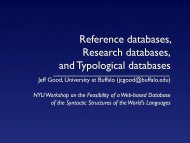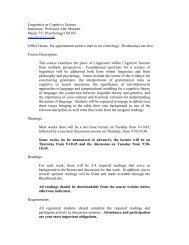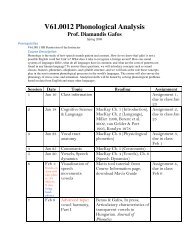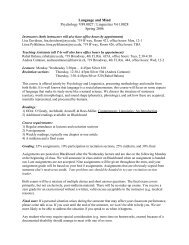Syllabus Syntax I LING-GA 1310-001 Instructor - NYU > Department ...
Syllabus Syntax I LING-GA 1310-001 Instructor - NYU > Department ...
Syllabus Syntax I LING-GA 1310-001 Instructor - NYU > Department ...
Create successful ePaper yourself
Turn your PDF publications into a flip-book with our unique Google optimized e-Paper software.
<strong>Syllabus</strong> <strong>Syntax</strong> I <strong>LING</strong>-<strong>GA</strong> <strong>1310</strong>-<strong>001</strong><br />
<strong>Instructor</strong>: Professor Chris Collins<br />
Office: 10 Washington Place, Room 411<br />
E-Mail: cc116@nyu.edu<br />
Phone: 28763<br />
Time: TR, 2:00PM- 3:15PM<br />
Place: 10Washington Place, Room 103<br />
Office Hours: Wednesday 10-12 (or by appointment)<br />
Course Description:<br />
<strong>Syntax</strong> I and II together form a comprehensive introduction to the concepts and principles<br />
of syntactic theory, in the framework of Principles and Parameters and Minimalism.<br />
<strong>Syntax</strong> I is concerned with phrase structure, argument structure (unaccusatives, unergatives,<br />
transitives, double object constructions, psych-verbs), Case and agreement (Agree), A-movement<br />
(passives, raising constructions), head movement, binding and control.<br />
<strong>Syntax</strong> II will cover A’-movement, the left periphery, differences between A- and A’-<br />
movement, weak and strong crossover, remnant movement, successive cyclic movement, general<br />
constraints on movement (minimalist conception of phases, relativized minimality), that-trace effects,<br />
the adjunct/argument asymmetry, covert movement (QR, Wh-in situ) and multiple wh-questions.<br />
Emphasis will be on reading the primary literature and writing a research paper.<br />
Course Requirements<br />
Problem Sets<br />
You may work on problem sets together, but all written work must be your own (e.g., you cannot<br />
copy the wording of your classmate and submit it as your own work). There will be around 5<br />
problem sets throughout the semester.<br />
Presentation<br />
Students will form small groups, and each group will give a presentation of a selected paper from<br />
the syllabus.<br />
Final Paper<br />
You may either (a) critically review a paper that has not been discussed in class, or (b) write a<br />
squib. Final papers are due on the last day of class: December 13.<br />
Grading<br />
Attendance and participation 10%<br />
Problem sets/Homework 50%<br />
Presentation in Class 10%<br />
Final Paper 30%<br />
Course Materials<br />
You are not required to purchase any materials for this class. All readings will be posted to our<br />
course website on Blackboard.<br />
1
I have posted the following forthcoming textbook online for people to use as a background<br />
reference.<br />
Koopman, Hilda, Dominique Sportiche, and Ed Stabler (to appear). An Introduction to Syntactic<br />
Analysis and Theory.<br />
Other Useful Resources<br />
Baltin, Mark and Chris Collins. 2<strong>001</strong>. The Handbook of Contemporary Syntactic Theory. Malden,<br />
MA: Blackwell.<br />
Everaert, Martin and Henk van Riemsdijk. 2006. The Blackwell Companion to <strong>Syntax</strong>. Malden,<br />
MA: Blackwell.<br />
Boeckx, Cedric. 2011. The Oxford Handbook of Linguistic Minimalism. Oxford University Press,<br />
Oxford.<br />
Adger, David. 2003. Core <strong>Syntax</strong>: A Minimalist Approach. Oxford University Press, Oxford.<br />
[Chapters 1-5 posted on Blackboard]<br />
Helpful Links for Syntacticians<br />
Blackwell Linguistic Compass<br />
http://linguistics-compass.com/syntax-morphology/<br />
Lingbuzz (hot new papers on syntax)<br />
http://ling.auf.net/lingBuzz<br />
Standford Encyclopedia of Philosophy (articles relevant to semantics)<br />
http://plato.stanford.edu/<br />
50 Years of Linguistics at MIT (see the videos on syntax and semantics)<br />
http://ling50.mit.edu/<br />
MIT Working Papers in Linguistics<br />
http://mitwpl.mit.edu/<br />
EA<strong>LING</strong> archives (videos and handouts, EA<strong>LING</strong> stands for Ecole d'Automne de Linguistique)<br />
http://ealing.cognition.ens.fr/ealing2012/site/PreviousEalings<br />
The syntax of natural language: An online introduction using the Trees program<br />
Beatrice Santorini , Anthony Kroch<br />
http://www.ling.upenn.edu/~beatrice/syntax-textbook/index.html<br />
World Atlas of Language Structures (online database)<br />
(it can be addictive to start playing with this)<br />
http://wals.info/<br />
Syntactic Structures of the World’s Languages (online database)<br />
http://sswl.railsplayground.net/<br />
The AFRANAPH Project (online database)<br />
http://www.africananaphora.rutgers.edu/<br />
Approaching Islands (syllabus)<br />
http://idiom.ucsd.edu/~goodall/225s11/syllabus<br />
2
<strong>Syllabus</strong>:<br />
Week 1: Sept. 4, 6 Introduction to Course, A Brief History of Generative Grammar,<br />
Properties of Merge<br />
Collins, Chris and Ed Stabler. 2012. A Formalization of Minimalist <strong>Syntax</strong>. Ms., <strong>NYU</strong> and UCLA.<br />
Chomsky, Noam. 1995. Chapter 4 in The Minimalist Program. Cambridge: MIT Press. [excerpt:<br />
pp. 241-249]<br />
Week 2: Sept. 11, 13 IP, CP and Head Movement<br />
Lasnik, Howard. 1995. The Forms of Sentences. An Invitation to Cognitive Science: Language,<br />
Vol. 1. Cambridge: MIT Press, pp. 283-310.<br />
Pollock, Jean-Yves. 1989. Verb Movement, Universal Grammar, and the Structure of IP. Linguistic<br />
Inquiry 20, 3: 365-424. [Selected Pages]<br />
Extra:<br />
Lasnik, Howard and Juan Uriagereka. 2002. On the Poverty of Stimulus Challenge. The Linguistic<br />
Review 19: 147-150.<br />
Roberts, Ian. 2011. Head Movement and the Minimalist Program. In Cedric Boeckx (ed.), The<br />
Oxford Handbook of Linguistic Minimalism. Oxford University Press, Oxford.<br />
Week 3: Sept. 18, 20 Word Order and Typology<br />
Kayne, Richard. 1994. The Antisymmetry of <strong>Syntax</strong>. MIT Press, Cambridge.<br />
Cinque, Guglielmo. 2005. Deriving Greenberg’s Universal 20 and its Exceptions. Linguistic<br />
Inquiry 36.3, pgs. 315-332.<br />
Extra:<br />
Longobardi, Giuseppe. 1994. Reference and Proper Names: A Theory of N-Movement in <strong>Syntax</strong><br />
and Logical Form. Linguistic Inquiry 25.4, pgs. 609-665.<br />
Bernstein, Judy. 2<strong>001</strong>. The DP Hypothesis: Identifying Clausal Properties in the Nominal Domain.<br />
In The Handbook of Contemporary Syntactic Theory, Mark Baltin and Chris Collins (eds.), pp.<br />
536-561.<br />
Bernstein, Judy. 2008. Reformulating the Determiner Phrase Analysis. Language and Linguistics<br />
Compass 2, pgs. 1-25.<br />
Abney, Steven Paul. 1987. The English Noun Phrase in its Sentential Apsect. Doctoral<br />
Dissertation, MIT.<br />
3
Week 4: Sept. 25, 27 Case Theory, Agree and Uninterpretable Features<br />
Pesetsky, David and Esther Torrego. 2011. Case. In Cedric Boeckx (ed.), The Oxford Handbook of<br />
Linguistic Minimalism. Oxford University Press, Oxford.<br />
Lasnik, Howard and Juan Uriagereka. 1988. A Course in GB <strong>Syntax</strong>. MIT Press, Cambridge.<br />
[Section 1.4] [NOT YET POSTED ON BLACKBOARD]<br />
Extra:<br />
Vergnaud, Jean-Roger. 1977. Letter to Noam Chomsky and Howard Lasnik.<br />
Legate, Julie. 2008. Morphological and Abstract Case. Linguistic Inquiry 39.1, pgs. 55-101.<br />
Marantz, Alec. 2000. Case and Licensing. In Proceedings of ESCOL, 234–253.<br />
Cornell Linguistics Club. Republished in Reuland (2000), pp. 11–30.<br />
Adger, David. 2010. A Minimalist Theory of Feature Structure. In Kibort and Corbett (eds.),<br />
Features. Oxford University Press, Oxford<br />
Week 5: Oct. 2, 4 Binding Theory: The Basics<br />
Koopman, Hilda, Dominique Sportiche, and Ed Stabler (to appear). An Introduction to Syntactic<br />
Analysis and Theory. [Chapters 7 and 13]<br />
Week 6: Oct. 9, 11 Binding Theory: Reconstruction<br />
Barss, Andrew. 2002. Syntactic Reconstruction Effects. In Baltin and Collins (eds.), The<br />
Handbook of Contemporary Syntactic Theory. Blackwell.<br />
Huang, C.-T. James. 1993. Reconstruction and the Structure of VP: Some Theoretical<br />
Consequences. Linguistic Inquiry 24.1, pgs. 103-138.<br />
Extra:<br />
Pesetsky, David. 2012. Phrasal Movement and its Discontents: Diseases and Diagnoses. To appear<br />
in Lisa Cheng & Norbert Corver (eds.), Diagnostics in <strong>Syntax</strong>, Oxford University Press.<br />
Sportiche, Dominique. 1988. A Theory of Floating Quantifiers and its Corollaries for Constituent<br />
Structure. Linguistic Inquiry 19.3, pgs. 425-449.<br />
McCloskey, Jim. 1997. Subjecthood and Subject Positions. In Liliane Haegeman (ed.), Elements of<br />
Grammar. Kluwer Academic Publishers, Dordrecth.<br />
Week 7: Oct. 16 (Fall Break), 18 Binding Theory: Minimalist Issues<br />
Extra:<br />
4
Reuland, E., 2011. Anaphora and Language Design. Cambridge, MA: MIT. [Chapters: TBA]<br />
[NOT YET POSTED ON BLACKBOARD]<br />
Hornstein, Norbert. 2<strong>001</strong>. Move: A Minimalist Theory of Construal. Blackwell, Oxford. [Chapter<br />
5: Is the Binding Theory Necessary?]<br />
Kayne, Richard. 2002. Pronouns and Their Antecedents. In Samuel David Epstein and T. Daniel<br />
Seely (eds.), Derivation and Explanation in the Minimalist Program. Blackwell, Oxford.<br />
Week 8: Oct. 23, 25 Binding Theory: Pronominal Agreement<br />
Collins, Chris and Paul Postal. 2012. Imposters. MIT Press, Cambridge. [Chapters 1-4, 7]<br />
Extra:<br />
Baker, Mark. 2008. The <strong>Syntax</strong> of Agreement and Concord. Cambridge, England, Cambridge<br />
University Press.<br />
Week 9: Oct. 30, Nov. 1 Raising and Control: The Basics<br />
Koopman, Hilda, Dominique Sportiche, and Ed Stabler (to appear). An Introduction to Syntactic<br />
Analysis and Theory. [Chapter 9: Infinitival Complements: Raising and Control]<br />
Week 10: Nov. 6, 8 Raising and Control: The Debate<br />
Tuesday:<br />
Thursday:<br />
Student Presentation<br />
Student Presentation<br />
Bobaljik, Jonathan David and Idan Landau. 2009. Icelandic Control is not A-Movement: The Case<br />
from Case. Linguistic Inquiry 40, 1: 113-154.<br />
Boeckx, Cedric and Norbert Hornstein. 2004. Movement Under Control. Linguistic Inquiry 35.3,<br />
pgs. 431-452.<br />
Extra:<br />
Hornstein, Norbert. 1999. Movement and Control. Linguistic Inquiry 30, 1: 69-96.<br />
Landau, Idan. 2003. Movement out of Control. Linguistic Inquiry 34: 471-498.<br />
Week 11: Nov. 13, 15 Argument Structure: VP-Shells<br />
Thursday:<br />
Student Presentation<br />
Barss, Andrew and Howard Lasnik. 1986. A Note on Anaphors and Double Objects. Linguistic<br />
Inquiry 17: 347-354.<br />
Pylkkänen, Liina. 2008. Introducing Arguments. Cambridge: MIT Press, pp. 1-64.<br />
5
Extra:<br />
Breuning, Benjamin. 2010. Double Object Constructions Disguised as Prepositional Datives.<br />
Linguistic Inquiry 41.2, pgs. 287-305.<br />
Larson, Richard. 1988. On the Double Object Construction. Linguistic Inquiry 19: 335-391.<br />
Baker, Mark and Collins Chris. 2006. Linkers and the Internal Structure of the vP. Natural<br />
Language and Linguistic Theory 24, pgs. 307-354.<br />
Week 12: Nov. 20, 22 (Thanksgiving) Catch-Up/Review<br />
Week 13: Nov. 27, 29 Argument Structure: Unergatives, Unaccusatives, Need/Have<br />
Thursday:<br />
Student Presentation<br />
Harley, Heidi. 2011. A Minimalist Approach to Argument Structure. In Cedric Boeckx (ed.), The<br />
Oxford Handbook of Linguistic Minimalism, pgs. 427 – 448. Oxford University Press, Oxford.<br />
Harves, Stephanie and Richard Kayne. 2012. Having Need and Needing Have. Linguistic Inquiry<br />
43.1, pgs. 120-132.<br />
Extra:<br />
Levin, Beth and Malka Rappaport Hovav. 1995. Chapters 1-2 in Unaccusativity. Cambridge, MA:<br />
MIT Press.<br />
Week 14: Dec. 4, 6 Argument Structure: Types of Objects<br />
Postal, Paul. 2010. Edge-Based Clause <strong>Syntax</strong>. MIT Press, Cambridge [Forward and Chapter 2:<br />
Objects and Arrays, pgs. 47 -74] [NOT YET POSTED ON BLACKBOARD]<br />
Extra:<br />
Landau, Idan. 2010. The Locative <strong>Syntax</strong> of Experiencers. MIT Press, Cambridge.<br />
[NOT YET POSTED ON BLACKBOARD]<br />
Week 15: Dec. 11, 13 Passive<br />
Thursday: Student Presentation<br />
Collins, Chris. 2005. A Smuggling Approach to the Passive in English. <strong>Syntax</strong> 8, 2: 81-120.<br />
Chomsky, Noam. 1957. Syntactic Structures. Mouton de Gruyter, Berlin. [Selected Sections]<br />
[NOT YET POSTED ON BLACBOARD]<br />
Extra:<br />
Baker, Mark, Kyle Johnson and Ian Roberts. 1989. Passive Arguments Raised. Linguistic Inquiry.<br />
20: 219-251.<br />
6
Kratzer, Angelika. 1996. Severing the external argument from its verb. In J. Rooryck and L. Zaring<br />
(eds.), Phrase Structure and the Lexicon. Dordrecht: Kluwer, 109-137.<br />
7


